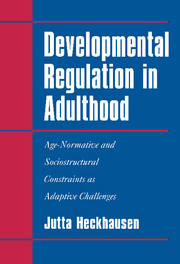 Developmental Regulation in Adulthood
Developmental Regulation in Adulthood Book contents
- Frontmatter
- Contents
- Acknowledgments
- List of Tables and Figures
- Introduction
- 1 Selectivity and Failure Compensation as Fundamental Requirements of Human Behavior and Development
- 2 The Life Course as a Context of Action
- 3 Primary and Secondary Control across the Life Span
- 4 A Model of Developmental Regulation across the Life Span
- 5 Developmental Goals as Organizers of Developmental Regulation
- 6 Developmental Regulation in Different Life-Course Ecologies
- 7 Social Comparisons as Prototypical Strategies in Developmental Regulation
- 8 Conclusions and Prospects for Future Research
- References
- Name Index
- Subject Index
3 - Primary and Secondary Control across the Life Span
Published online by Cambridge University Press: 05 September 2009
- Frontmatter
- Contents
- Acknowledgments
- List of Tables and Figures
- Introduction
- 1 Selectivity and Failure Compensation as Fundamental Requirements of Human Behavior and Development
- 2 The Life Course as a Context of Action
- 3 Primary and Secondary Control across the Life Span
- 4 A Model of Developmental Regulation across the Life Span
- 5 Developmental Goals as Organizers of Developmental Regulation
- 6 Developmental Regulation in Different Life-Course Ecologies
- 7 Social Comparisons as Prototypical Strategies in Developmental Regulation
- 8 Conclusions and Prospects for Future Research
- References
- Name Index
- Subject Index
Summary
Now that the fundamental requirements for developmental regulation and the biological sociostructural and age-normative constraints have been outlined in the previous chapter, this chapter will address the means of control available to the individual to meet the demands of developmental regulation. The basic functional characteristics of control-related behavior and its change across the human life span are conceptualized in the life-span theory of control (J. Heckhausen & Schulz 1995). First, conceptually important dimensions for distinguishing various kinds of control-related behavior are discussed. Subsequently, relevant findings from diverse areas of research pertaining to all age groups from infancy to old age are considered and integrated into the new theoretical framework.
Humans strive to produce behavior-event contingencies and thereby to exert control over the environment. This fundamental motivator of behavior is shared with many other species, at least with all mammals. Numerous studies on both humans and nonhuman mammals have shown that behavior-event contingencies bear reinforcing potential in their own right, irrespective of consummatory behavior (White 1959). Thus, for instance, children as well as rats prefer rewards that are contingent on their own behavior over rewards that are noncontingent on their own behavior (Singh 1970).
A deeply rooted desire for behavior-event contingencies is adaptive, because it provides a generalized motivator for adaptive action that reaches in scope far beyond a restricted set of drive-related goals.
- Type
- Chapter
- Information
- Developmental Regulation in AdulthoodAge-Normative and Sociostructural Constraints as Adaptive Challenges, pp. 62 - 84Publisher: Cambridge University PressPrint publication year: 1998


